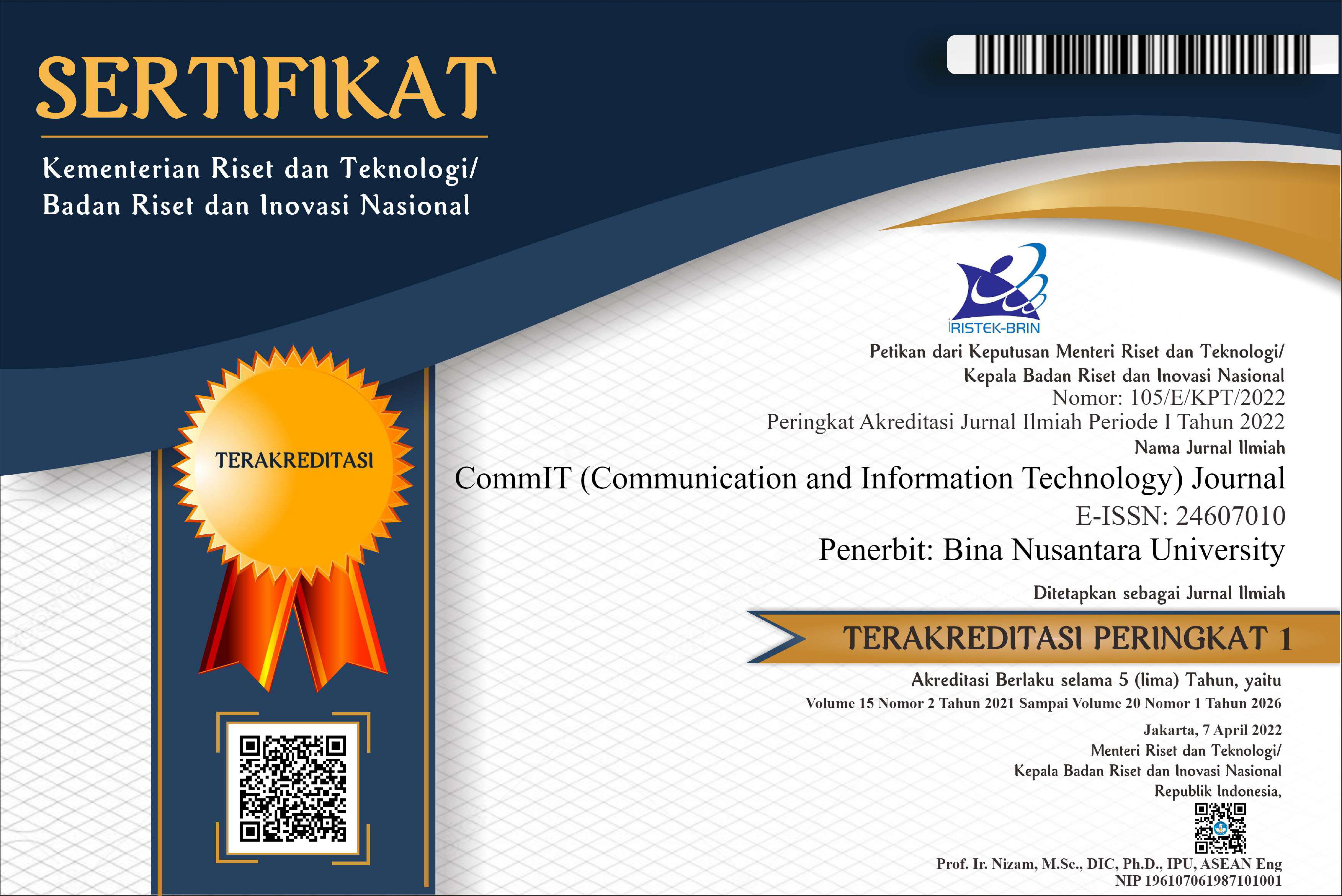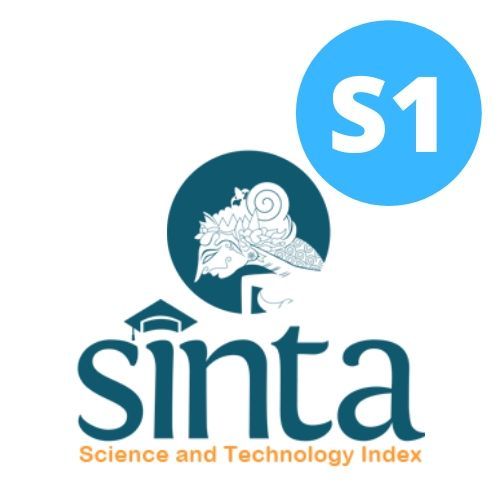Performance Analysis on IEEE 802.11ah Standard with Enhanced Distributed Channel Access Mechanism
DOI:
https://doi.org/10.21512/commit.v12i1.3908Keywords:
AIFS, EDCA, IEEE 802.11ah, QoS, RAWAIFS, RAWAbstract
IEEE 802.11ah is a new task group on the IEEE 802.11 standard designed to work on the 900 MHz. It is with a range of communication coverage up to 1
kilometer, lower energy consumption, and up to 8191 stations. There are two types of STAs in 802.11ah: sensor type to support sensor service and non-sensor type for offload service. In this research, it only focuses on non-sensor STA. For non-sensor STA, maximizing throughput is more important than power consumption. This research aims to see the performance of IEEE 802.1 1ah with Enhanced Distributed Channel Access (EDCA). To achieve that purpose, a mechanism is needed to provide guarantees various services required by the
STA. EDCA is an access mechanism used to set the Quality of Service (QoS) for the IEEE 802.11 standard through modifications in MAC layer. In this research,
it focuses on one of the EDCA parameters, Arbitration Inter-Frame Space (AIFS). In addition, this research also focuses on the 802.11ah feature is Restricted Access Window (RAW) by changing the number of the RAW groups. From the results of the research, it is found that the improvement scheme with Arbitration Inter-Frame Space Number (AIFSN) value AC BK = 2, AC BE = 1, AC VI = 1, AC VO = 1 has better performance compared to the default scheme with AIFSN value AC BK = 7, AC BE = 3, AC VI = 2, AC VO = 2) with an average throughput of 1.504598 Mbps, average overall delay of 0.066242 second and average PDR of 62%. In addition, changes in the number of RAW groups and RAW slots affect network performance. This feature can improve the value of throughput, average delay, and Packet Delivery Ratio. The goals of this research is to know the effect of AIFSN value changes on AIFSN parameters, variation of RAW group and RAW slot number to throughput,
average delay and packet delivery ratio.
Plum Analytics
References
Y. Zhao, “Analysis of energy efficiency in ieee 802.11ah,” Master’s thesis, Masters Programme in Communications Engineering, Aalto University, 2015.
N. Daneshfar, “Performance enhancement mechanism of ieee 802.11ah machine communication system,” Master’s thesis, Department of Electronics and Communications Engineering, Faculty of Computing and Electrical Engineering, Tampere University of Technology, 2015.
M. Park, “IEEE 802.11 ah: Energy efficient mac protocols for long range wireless lan,” in IEEE International Conference on Communications (ICC). IEEE, 2014, pp. 2388–2393.
IEEE standard for information technology–Telecommunications and information exchange between systems–Local and metropolitan area networks–Specific requirements–Part 11: Wireless LAN Medium Access Control (MAC) and Physical Layer (PHY) specifications Amendment 6: Wireless Access in Vehicular Environments, IEEE 802.11 Working Group Std., 2010.
S. Prasetya, B. Rahmat, and E. Susanto, “Quality of service improvement with 802.11 e EDCA scheme using enhanced adaptive contention window algorithm,” in IEEE International Conference on Communication, Networks and Satellite (COMNESTAT). IEEE, 2015, pp. 80–85.
R. Achary, V. Vaithiyanathan, P. Raj, and S. Nagarajan, “Performance enhancement of IEEE 802.1 le wlan by dynamic adaptive contention window,” in 16th International Conference on
Advanced Communication Technology (ICACT). IEEE, 2014, pp. 447–452.
R. Qashi, M. Bogdan, and K. H¨anssgen, “Case study: The effect of variable priority parameters on the qos of wlans ieee 802.11 e EDCF,” in IEEE 3rd International Conference on Communication
Software and Networks (ICCSN). IEEE, 2011, pp. 104–108.
L. Tian, S. Deronne, S. Latr´e, and J. Famaey, “Implementation
and validation of an ieee 802.11 ah module for ns-3,” in Proceedings of the Workshop on ns-3. ACM, 2016, pp. 49–56.
S. S. B, “A quantitative analysis of 802.11ah wireless standard,” International Journal of Latest Research in Engineering and Technology (IJLRET), vol. 2, no. 2, pp. 26–29, 2016.
T. Anwar and W. G. P. Mui, “Design and implementation of a wireless network system in a smart campus,” CommIT (Communication and Information Technology) Journal, vol. 1, no. 2,
pp. 127–139, 2007.
M. I. Denatama, D. Perdana, and R. M. Negara, “Analisis perbandingan kinerja protokol routing DSDV dan OLSR untuk perubahan kecepatan mobilitas pada standar IEEE 802.11 ah,” Jurnal Infotel, vol. 8, no. 2, pp. 100–106, 2016.
M. Qutab-ud din, “Enhancements and challenges in ieee 802.11ah - a sub-gigahertz wi-fi for iot applications,” Master’s thesis, Department of Electronics and Communications Engineering, Faculty
of Computing and Electrical Engineering, Tampere University of Technology, 2015.
Downloads
Published
Issue
Section
License
Authors who publish with this journal agree to the following terms:
a. Authors retain copyright and grant the journal right of first publication with the work simultaneously licensed under a Creative Commons Attribution License - Share Alike that allows others to share the work with an acknowledgment of the work's authorship and initial publication in this journal.
b. Authors are able to enter into separate, additional contractual arrangements for the non-exclusive distribution of the journal's published version of the work (e.g., post it to an institutional repository or publish it in a book), with an acknowledgment of its initial publication in this journal.
c. Authors are permitted and encouraged to post their work online (e.g., in institutional repositories or on their website) prior to and during the submission process, as it can lead to productive exchanges, as well as earlier and greater citation of published work.
USER RIGHTS
All articles published Open Access will be immediately and permanently free for everyone to read and download. We are continuously working with our author communities to select the best choice of license options, currently being defined for this journal as follows: Creative Commons Attribution-Share Alike (CC BY-SA)




















